After the day in Passau, we returned to the ship which was now out of dry dock in Linz. We boarded the boat and began sailing up the Danube towards Regensberg. We wouldn’t get all the way there, so the plan was for the boat to make a brief stop in Deggendorf. 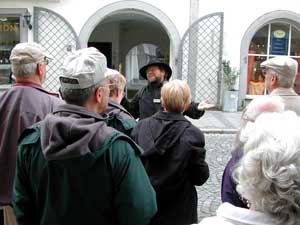 We would disembark there and use buses to complete the day’s activities, in reverse order. So, we got off the boat in Deggendorf about 9 a.m. for an hour’s bus ride past Kelheim and Regensburg to the Weltenburg Abbey. We arrived there late and really had to hustle through the Abbey. It was under reconstruction from the floods of 1999 and 2002 and 2003, so there wasn’t a lot to be seen, anyway. Abbeys, monasteries, and nunnery’s (convents) aren’t my first priority, anyway.
We would disembark there and use buses to complete the day’s activities, in reverse order. So, we got off the boat in Deggendorf about 9 a.m. for an hour’s bus ride past Kelheim and Regensburg to the Weltenburg Abbey. We arrived there late and really had to hustle through the Abbey. It was under reconstruction from the floods of 1999 and 2002 and 2003, so there wasn’t a lot to be seen, anyway. Abbeys, monasteries, and nunnery’s (convents) aren’t my first priority, anyway.
The navigable part of the Danube river ends at Kelheim while the river itself continues upstream for a couple hundred miles. There are some day boats that traverse the river between Kelheim and Weltenburg — about a 45 minute boat ride up river and a 20 minute boat ride downriver — through some very scenic parts of the river. So, after a whirlwind 20 minute run-by, we left the Weltenburg Abbey and boarded one of the day boats for the trip downstream to Kelheim. Normally we would then have spent some time in Kelheim, but because of the change in plans, all we did was get off the day boat, board the busses, and then drove to Regensburg for lunch and the rest of the day.
The boat trip down the Danube was actually quite beautiful. The area is a National Park and only a few registered boats are allowed on this part of the river, so I guess a pleasure boat wouldn’t be able to traverse the area. In fact, we saw very few pleasure boats until we were near Koeln. I think it would be great fun to take a larger pleasure boat (one that you can live and sleep on) on this same trip and take a couple of months to make the voyage.
Regensburg was definitely a highlight of the trip. The city in the 12th and 13th centuries was enormously wealthy (along with all the attendant problems between church and state) because of its location on the major trade routes through Europe. The city was founded originally by the Romans in about 170 A.D. when a legion of soldiers was stationed there (a legion is about 8,000 soldiers!). Regensburg sits on the northernmost point on the Danube River and for several hundred years, the Roman Empire ended at this point. However, the Turks got quite ambitious in the 14th century, taking over most of Eastern Europe, including parts of Austria and all of Hungary. As a result, the east-west trade evaporated. Further, because of the Turkish presence, the north-south trade routes shifted much further west. In a few short years, Regensburg went from wealthy to bankrupt. That proved to be to the city’s benefit today as all of the old city remains. No one could afford to build anything new, so the existing structures were simply reused. Since the city was built upon trade and not on agriculture or manufacturing, it also escaped the bombing in WWII. There was no manufacturing there to be a target!
Our tour guide in Regensburg was originally from Missouri. He first came to Regensburg to teach at the University. After his five-year contract expired, he decided to stay (perhaps persuaded by his German wife) and be a tourist guide and a house husband. He was apparently well known. As we went on the almost 90 minute tour, he was greeted often by other people in the familiar form of German. We found him to be very knowledgeable and very interesting (as well as quite dramatic as seen in the accompanying picture).
There were a couple of very interesting features in Regensburg. First were the high towers. In the Regensburg Golden Age, wealthy business men would build a high, square tower attached to their house. The tower had no other purpose than to show wealth. Nothing was stored in the towers, they were just empty shells about four or five stories tall shouting to the world, "I’ve got so much money, I can just build this tower and I don’t really need it!" Of the more than 70 towers built, about 25 of them are still standing.
Secondly was the interesting history with the Jews. There was a large Jewish population in Regensburg and most of them were business partners with other non-Jewish business men. During the First Crusade (about 1100 A.D.) mercenaries and soldiers roamed through Europe killing any Jews that they could find. To "protect" their Jewish business partners, all the Jews were rounded up, taken down to the Danube, forcefully baptized, and then registered on the Church rolls. When the soldiers came through Regensburg, there were no Jews. About a year later, the ArchBishop declared the baptisms to be null and void, and everything returned to normal. That lasted until the city plunged into bankruptcy. Someone was certainly to blame, and the blame was fixed on the Jews. They were forcefully removed from the city, the synagogue torn down, and the Jewish cemetery razed. The tombstones were then used as decorations in houses! Some large number of Jewish tombstones can be seen around the town embedded into the walls of houses.
Finally, there is a very impressive bridge across the Danube River in Regensburg. This stone bridge was built by the Romans and survived wars, pestilance, plagues, and poverty. One span, however, did not survive the Nazi’s. They blew up one span as they were retreating. It has, of course, since been repaired.
We would definitely return to Regensburg. We only scratched the surface of what there was to see and do in this city. As we finished the day, we had some strudel and hot chocolate in a small konditori on the second floor of the old Salt House. Our cruise ship meanwhile sailed upstream from Deggendorf and met us in Regensburg. We were almost back on schedule.
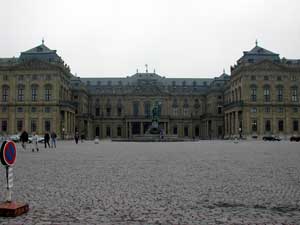
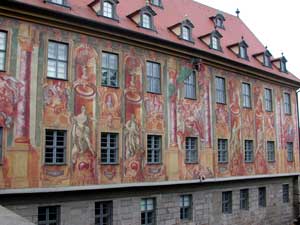 We spent a night and a day in Rothenberg on der Taube and had a delightful time (We’ll be in Rothenberg tomorrow) and then drove to Bamberg to spend the night and the next day. We didn’t find Bamberg to be so very interesting and about noon on our 1999 visit, left the city to go out in the countryside and then on to our next stop in Nuremberg. The write-up on Bamberg in our cruise itinerary sounded like a very different city than we had visited in 1999 so we were very curious to see what the guided tour of Bamberg would reveal.
We spent a night and a day in Rothenberg on der Taube and had a delightful time (We’ll be in Rothenberg tomorrow) and then drove to Bamberg to spend the night and the next day. We didn’t find Bamberg to be so very interesting and about noon on our 1999 visit, left the city to go out in the countryside and then on to our next stop in Nuremberg. The write-up on Bamberg in our cruise itinerary sounded like a very different city than we had visited in 1999 so we were very curious to see what the guided tour of Bamberg would reveal.
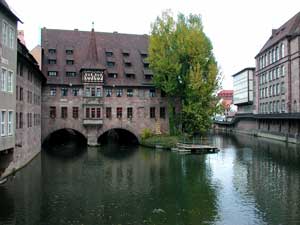 with some fairly hard rain showers in the late afternoon. Then the skies cleared up and sunshine appeared just as we were leaving town to go back to the boat. The day was very pleasant and much less hectic that the previous two days. It was good to have some downtime!
with some fairly hard rain showers in the late afternoon. Then the skies cleared up and sunshine appeared just as we were leaving town to go back to the boat. The day was very pleasant and much less hectic that the previous two days. It was good to have some downtime!
 We would disembark there and use buses to complete the day’s activities, in reverse order. So, we got off the boat in Deggendorf about 9 a.m. for an hour’s bus ride past Kelheim and Regensburg to the Weltenburg Abbey. We arrived there late and really had to hustle through the Abbey. It was under reconstruction from the floods of 1999 and 2002 and 2003, so there wasn’t a lot to be seen, anyway. Abbeys, monasteries, and nunnery’s (convents) aren’t my first priority, anyway.
We would disembark there and use buses to complete the day’s activities, in reverse order. So, we got off the boat in Deggendorf about 9 a.m. for an hour’s bus ride past Kelheim and Regensburg to the Weltenburg Abbey. We arrived there late and really had to hustle through the Abbey. It was under reconstruction from the floods of 1999 and 2002 and 2003, so there wasn’t a lot to be seen, anyway. Abbeys, monasteries, and nunnery’s (convents) aren’t my first priority, anyway.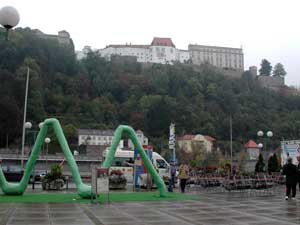
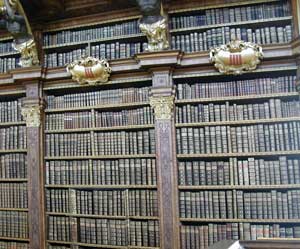 My command of English isn’t enough to describe this place, particularly the church in the Abby. I have never seen anything so ornate – to the point of being almost gaudy. The tour was centered on the Benedictine version of Catholicism, and I would have appreciated something much more historically focused. The major source of income for the Abby is tourism and about 450,000 people per year pay admission to tour a very small part of the Abby. The probably translates to some $5 million dollars a year just in entrance fees – perhaps more as I don’t know what the price of admission was. The library, having more than 150,000 books, was astounding. Anyone can come to the library, visit the reading room, and read any of the books. Those that are too old or fragile are on microfilm. The Abby has a current membership of 31 Benedictine Monks, 16 of whom live at the Abby. The rest are stationed at Parish churches around the country. I’d guess each of those 31 monks has available about 50 rooms apiece in the building. The Abbey is rectangular, three stories tall, with a large inner courtyard. Most impressive.
My command of English isn’t enough to describe this place, particularly the church in the Abby. I have never seen anything so ornate – to the point of being almost gaudy. The tour was centered on the Benedictine version of Catholicism, and I would have appreciated something much more historically focused. The major source of income for the Abby is tourism and about 450,000 people per year pay admission to tour a very small part of the Abby. The probably translates to some $5 million dollars a year just in entrance fees – perhaps more as I don’t know what the price of admission was. The library, having more than 150,000 books, was astounding. Anyone can come to the library, visit the reading room, and read any of the books. Those that are too old or fragile are on microfilm. The Abby has a current membership of 31 Benedictine Monks, 16 of whom live at the Abby. The rest are stationed at Parish churches around the country. I’d guess each of those 31 monks has available about 50 rooms apiece in the building. The Abbey is rectangular, three stories tall, with a large inner courtyard. Most impressive.
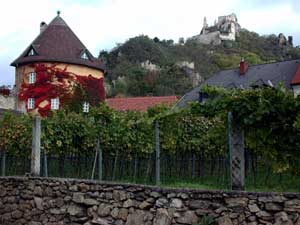 Our guides told us to be sure and remember it was a City and not a Village as Duernstein had obtained all the rights of a city, including the right to have an executioner, due to their loyalty to the monarchy during the 30-year war. It was a very quaint city well worth a visit. The city is built along a fairly steep hillside at a narrow point in the Danube River near the beginning of the Wachau Valley. The Wachau Valley is the source of an enormous amount of wine from vineyards all along the 20-mile long, narrow valley. The city was formed to collect tolls on the river and provide a way station for travelers (particularly royalty).
Our guides told us to be sure and remember it was a City and not a Village as Duernstein had obtained all the rights of a city, including the right to have an executioner, due to their loyalty to the monarchy during the 30-year war. It was a very quaint city well worth a visit. The city is built along a fairly steep hillside at a narrow point in the Danube River near the beginning of the Wachau Valley. The Wachau Valley is the source of an enormous amount of wine from vineyards all along the 20-mile long, narrow valley. The city was formed to collect tolls on the river and provide a way station for travelers (particularly royalty).